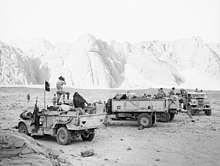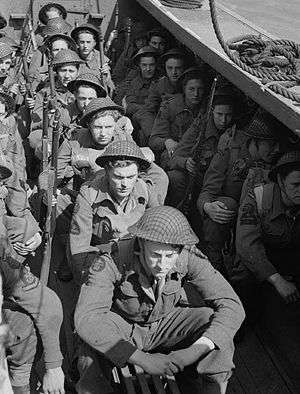Operation Agreement
Operation Agreement comprised a series of ground and amphibious operations carried out by British, Rhodesian and New Zealand forces on Axis-held Tobruk from 13 to 14 September 1942, during the Second World War. A Special Interrogation Group party, fluent in German, took part in missions behind enemy lines. Diversionary actions extended to Benghazi (Operation Bigamy), Jalo oasis (Operation Nicety) and Barce (Operation Caravan).[4][lower-alpha 1] The Tobruk raid was a disaster from the Allied point of view, and the British lost several hundred men killed and captured, one cruiser, two destroyers, six motor torpedo boats and dozens of small amphibious craft.
Background
The objective of Operation Agreement was to undermine the Axis war effort in North Africa by destroying airfields, harbour facilities, supply ships, vehicles and large oil stores.[6] The Allies also intended to capture Jalo oasis, which was to be used as a rendezvous for the retreating ground forces involved in the other operations.[7]
Prelude
G1 and T1 patrols of the Long Range Desert Group (LRDG) with 50 men, 12 light trucks and five jeeps assaulted Barce airfield and the main barracks, destroying 16 aircraft and damaging seven more.[8][9] In the attack on the barracks, the LRDG lost four men and two vehicles. Later near Zaptié the LRDG force was intercepted by an Italian motorised company with all but two lorries damaged or destroyed. The lorries were loaded with the most seriously injured, while the others went on foot for 99 mi (160 km). The Italians took seven New Zealanders and three Rhodesians prisoner, all injured. After a year, four of the New Zealanders were able to escape.[9]
The Lieutenant Colonel David Stirling and a party of the Special Air Service, supported by S1 and S2 patrols of the LRDG, were to attempt a big raid on Benghazi but after running late, their presence was discovered after a clash at a roadblock as dawn broke. With the element of surprise lost and the protection of darkness receding, Stirling ordered a withdrawal.[4] The attack on Jalo Oasis was carried out by the Sudan Defence Force and S1 and S2 patrols of the LRDG. The first attack on the night of 15/16 September, was easily repelled by the defenders, who were on the alert and had been reinforced. The attackers withdrew on 19 September as an Italian relief column approached the oasis.[9]
Main attack
Operation Agreement involved an amphibious force of about 400 Royal Marines, 180 Argyll and Sutherland Highlanders (Captain Norman MacFie) 14 Platoon, Z Company, I Battalion, Royal Northumberland Fusiliers (Lieutenant Ernest Raymond) army engineers and Force B (Lt. Col. John Edward Haselden) about 150 SAS approaching from the desert. The amphibious force was split into Force A, supported by destroyers and intended to land on the peninsula north of Tobruk, while Force C, composed of coastal units, was directed towards an inlet east of Tobruk harbour. Force B captured an Italian 152 mm coastal battery but this was quickly retaken by Italian marines from the San Marco Battalion. Haselden was killed in action. Most of the shore batteries and positions remained in Axis hands.[10]
Force A
Force E, a group of commandos from the submarine HMS Taku failed to set up beacons on the shore to guide the main British force, due to the bad sea conditions. The garrison had been reinforced and the destroyers HMS Sikh and Zulu bringing in the seaborne troops landed them on the wrong beach, far to the west of the intended landing place.[11] The British destroyer Sikh, which led the landing attempt, was hit by Italian 152 mm (6-inch) shore batteries and German 88 mm anti-tank guns, while taking on troops. Zulu had gone to the rescue but was unable to pull Sikh clear and it eventually sank; 122 crew were reported killed and the survivors were taken prisoner. On the afternoon of 14 September, while returning to Alexandria, HMS Coventry was badly damaged by German Ju 87 dive bombers from Crete and 63 crew were killed. Coventry was scuttled by Zulu which was hit by German Ju-87 and Ju-88 fighter-bombers [12] a little later. While under tow and 100 nmi (120 mi; 190 km) from Alexandria, Zulu sank with the loss of 39 crew.[13]
Force C

Another landing by Motor Launches and boats, carrying a detachment of Argyll and Sutherland Highlanders and a machine-gun platoon of Royal Northumberland Fusiliers, whose Vickers machine guns were to defend the perimeter, partially failed to reach the landing point. Because of extremely heavy fire from Tobruk harbour, only two Launches, MTB 261 and MTB 314, made it into Marsa Umm el Sciausc, the target cove. MTB 314 became stranded in the shallow water, but MTB 261 managed to land Sergeant 'Dusty' Miller and his group of Geordie Fusiliers and sail out.[14] The Motor Launches ML 353, Ml 352 and ML 349 and 17 MTBs were beaten off by boom defences and an Italian flotilla of torpedo boats and armed motor barges.[15][16] Three MTBs launched torpedoes at the naval vessels in harbour, to no avail.[17] ML 353 was set on fire and scuttled, either hit by the Italian warships or strafed by Italian Macchi C.200 fighters, while ML 352, MTB 308, MTB 310 and MTB 312 were lost to Axis aircraft.[15][16] MTB 314, the Motor Torpedo Boat that was damaged and run aground during the battle, was captured by the German harbour minesweeper R-10 at dawn, with 117 seamen and soldiers on board. Although they were frequently dive-bombed and strafed during their return journey, the bulk of the MTBs and the surviving ML reached Alexandria.[18]
Aftermath

Dozens of British sailors and marines were rescued from the sea and taken prisoner by the Italian Spica-class torpedo boat Castore, the Generali-class Montanari, the armed tug Vega, a flotilla of German harbour minesweepers and several German and Italian motor barges.[2] A number of makeshift motor amphibious craft, stragglers from Force A and attempting to reach Alexandria at very low speed, were also captured with their crews.[19][20][21] A dinghy manned by the survivors of ML 352 following the same escape route was caught by Castore at midday.[22] Losses amounted to about 300 Royal Marines, 160 soldiers, 280 sailors, the anti-aircraft cruiser Coventry, the destroyers Sikh and Zulu, two motor launches, four MTBs and several small amphibious craft.[4] The Royal Marines suffered 81 killed, the navy suffered the loss of another 217 men in the ship sinkings; about 576 survivors were captured.[23] Axis losses were 15 Italians and one German killed, 43 Italians and seven Germans wounded.[4]
See also
- North African Campaign timeline
- Battle of the Mediterranean
- List of World War II battles
- British Commandos
Notes
- Daffodil, Snowdrop, Tulip and Hyacinth were fictitious code names, made up by the author of a book published in 1945, when the official names of the operations were secret and which came into general use.[5]
Footnotes
- Bragadin 1957, p. 220.
- L'operazione Daffodil nel piano Agreement (in Italian)
- Molinari & Anderson, 2007, p. 71
- Molinari & Anderson (2007), p. 71
- O'Carroll 2005, pp. 25–26
- Smith, pp. 22–23
- Molinari & Anderson (2007), p. 70
- O'Carroll 2005, p. 62
- Molinari & Anderson (2007), p. 72
- Playfair 2004, pp. 20–23.
- Smith, pp. 90–95
- Smith, p. 189
- Playfair 2004, p. 22.
- Smith, p. 111
- Bragadin, 1957 p. 220
- Sadler (2008), pp. 266–68
- Smith, p. 119
- Rohwer 2005 p. 196
- Smith, pp. 122, 144
- Smith, p. 213
- Sadler, p. 231-32
- Sadler (2008), p. 269
- "Operation "Agreement"". Archived from the original on 21 August 2018. Retrieved 28 January 2015.
References
- Bragadin, Marc'Antonio (1957). The Italian Navy in World War II. Annapolis, MD: United States Naval Institute. ISBN 978-0-405-13031-1.
- Landsborough, Gordon (1989). Tobruk Commando: The Raid to Destroy Rommel's Base. London: Presidio Press. ISBN 1-85367-025-1.
- Molinari, Andrea; Anderson, Duncan (2007). Desert Raiders: Axis and Allied Special Forces 1940–43. Oxford: Osprey. pp. 68–73. ISBN 978-1-84603-006-2.
- O'Carroll, Brendan (2004). The Barce Raid. Wellington, NZ: Ngaio Press. ISBN 0-9582243-8-2.
- Playfair, Major-General I. S. O.; et al. (2004) [1st. pub. HMSO 1966]. Butler, J. R. M. (ed.). The Mediterranean and Middle East: The Destruction of the Axis Forces in Africa. History of the Second World War United Kingdom Military Series. IV (Naval & Military Press ed.). London: HMSO. ISBN 1-84574-068-8.
- Rohwer, Jürgen; Hümmelchen, Gerhard; Weis, Thomas (2005). Chronology of the War at Sea 1939–1945: The Naval History of World War Two (3rd rev. ed.). London: Chatham. ISBN 1-86176-257-7.
- Sadler, John (2016). Operation Agreement: Jewish Commandos and the Raid on Tobruk. London: Bloomsbury. ISBN 978-1-4728-1489-0.
- Smith, Peter Charles (1987). Massacre at Tobruk: The Story of Operation Agreement. London: Kimber. ISBN 0-7183-0664-3.
Further reading
- H. M. Ships Damaged or Sunk by Enemy Action, 3rd September, 1939 to 2nd September, 1945 (PDF). London: Admiralty: Director of Naval Construction. 1952. OCLC 38570200. Archived from the original (PDF) on 10 June 2016. Retrieved 26 November 2018.
- Pitt, B. (2001) [1982]. The Crucible of War: Montgomery and Alamein. III (Three volume pbk. edition of the two volumes published in 1980 and 1982 ed.). London: Cassell & Co. ISBN 978-0-304-35952-3.
- Richards, D.; St G. Saunders, H. (1975) [1954]. Royal Air Force 1939–45: The Fight Avails. II (repr. ed.). London: HMSO. ISBN 978-0-11-771593-6. Retrieved 13 December 2015.
- Roskill, S. W. (1956). The Period of Balance. History of the Second World War United Kingdom Military Series: The War at Sea 1939–1945. II. London: HMSO. OCLC 174453986. Retrieved 26 November 2018.
